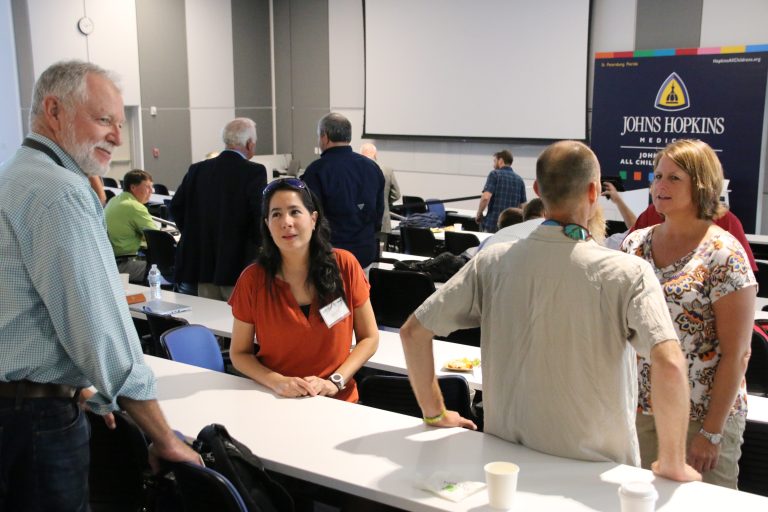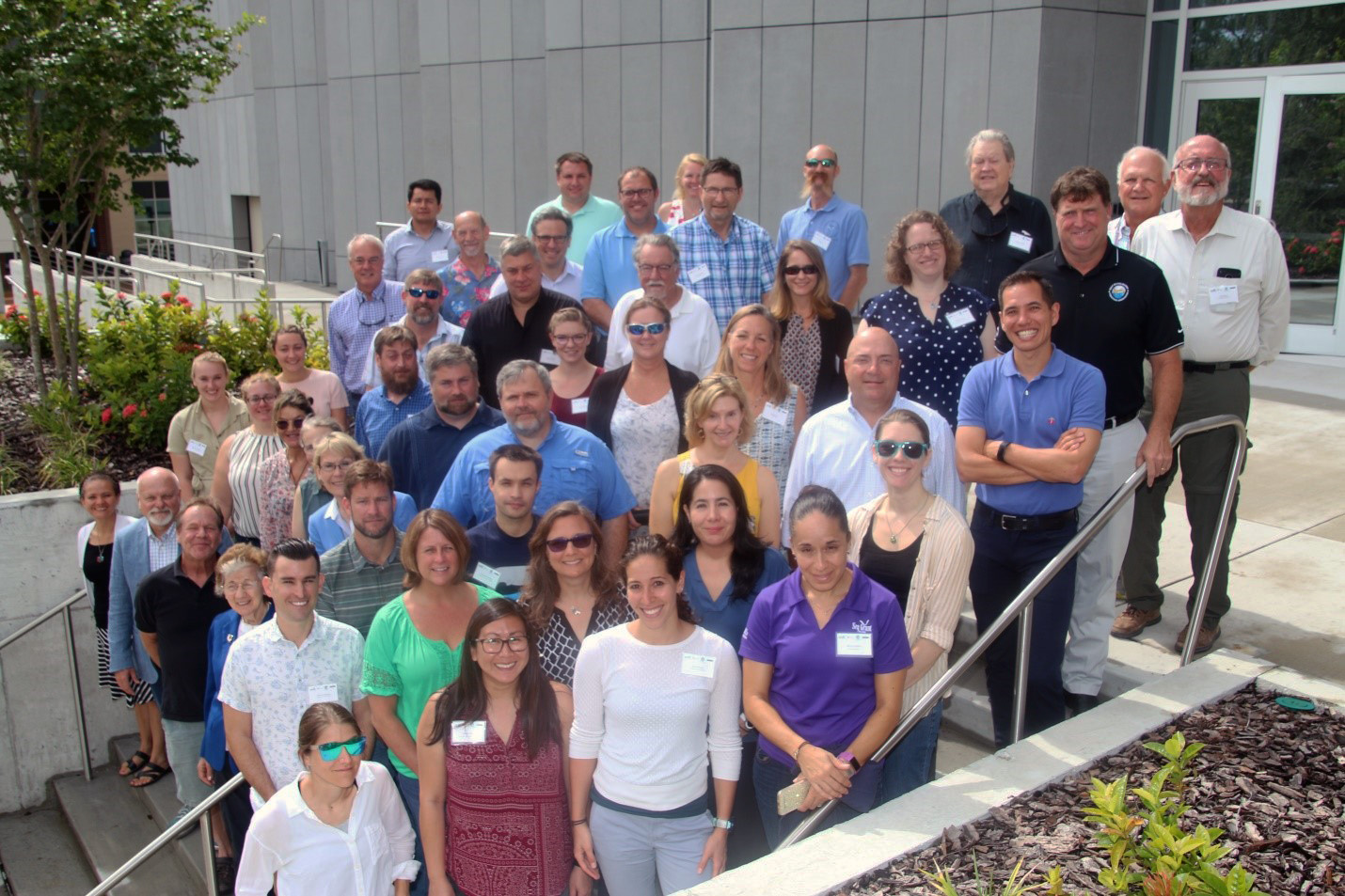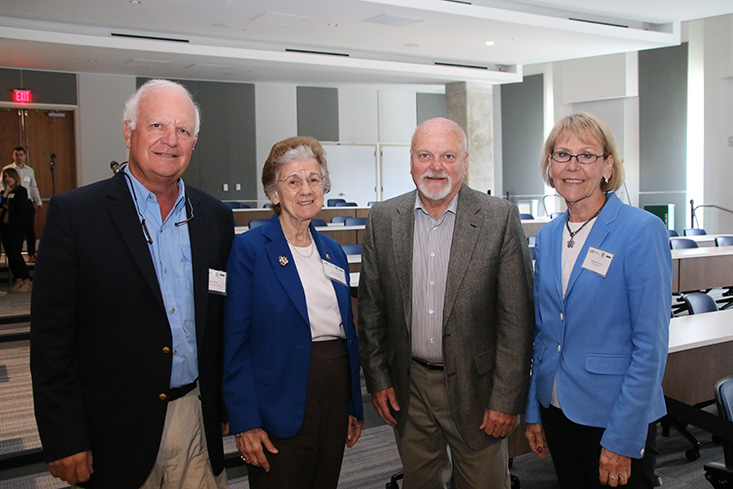Written by Sean Beckwith, Web Content Developer for USF CMS
ST. PETERSBURG, FL – April 20th, 2020, will be the 10th anniversary of the Deepwater Horizon (DWH) oil-well blowout, the lives it took, and the damage inflicted upon the environment. Funding provided through the Gulf of Mexico Research Initiative (GoMRI), established in the wake of the disaster, is coming to completion, and large, multi-institution teams of scientists are working to make sense of the body of knowledge produced post-DWH.
A core team met most recently in St. Petersburg, FL from July 23-25 to participate in a workshop entitled “Ecosystem Impacts of the Deepwater Horizon Event: Assembling the Record of Species and Community Change.” The workshop was organized by C-IMAGE, the research consortium of 19 U.S. and international partners that is tasked with understanding the impacts of the spill and is based at the USF College of Marine Science.
“We have several working theories at this stage, and are excited to keep our momentum going in the final stretch,” said Dr. Steve Murawski, who leads the C-IMAGE effort. Murawski is a Professor and St. Petersburg Downtown Partnership Peter R. Betzer Endowed Chair at the USF College of Marine Science. “It continues to be an honor and privilege to unearth new understanding in the wake of such a historic disaster that devastated too many lives and families.”
Here’s a snapshot of a few of the working hypotheses that will be refined over the next several months, Murawski said:
- The Deepwater Horizon incident resulted in one of the most complex and diverse sets of ecosystem impacts in the history of oil spills, ranging from trivial to catastrophic—and concerns abound that the system is less resilient to ongoing environmental stressors, such as overfishing, nutrient pollution, hurricanes, and climate change.
- Many resources have still not fully recovered, and for some it could take several more decades to a century or more.
- Two major chronic “reservoirs” of oil residue remain in the deep benthic and coastal wetland environment.
- With industry pushing to move to deeper Gulf waters, we must prioritize research to better understand the ecology of this poorly understood environment.
- The daily vertical migration of small animals in the Gulf’s mid-depths acts as an “elevator” that brings oil to the surface, where it can contaminate surface animals.
- Some inshore countermeasures to the spill were not only ineffective but counterproductive.
- The impacts of the spill on Gulf fisheries are complex. Most species along the continental shelf will experience a modest to severe decrease in population but compounding factors exist that are tough to tease out, such as the rapid increase in invasive lionfish.
Diving Deeper
Chair of the GoMRI Research Board, Dr. Rita Colwell, praised the interdisciplinary science that has blossomed as a result of trying to understand the complex problems created by the oil spill. “The most critical part is the interaction between systems: being able to predict that when you push on one side it has an effect on the other,” Colwell said.
The synthesis of the DWH event and the wide-ranging impacts to the Gulf of Mexico and beyond were delegated to eight Core Area working groups whose combined efforts address the Spill Scenario, Oil Fate, and Ecosystem Consequences. Each of the Core Area groups will convene one or more times at GoMRI-sponsored workshops to put heads together, scratch brains, and, most importantly, communicate. The level of understanding gained through open discussion and ongoing collaborations is more valuable than the sum of its parts, as anyone who has been involved in the research effort since the beginning can tell you.

Kevin Shaw, Dr. Isabel Romero, Dr. Daniel Hahn, and Dr. Heather Judkins take advantage of a coffee break to discuss breakout sessions.
The main questions posed by the GoMRI Research Board to each of the Core Area working
groups were: what have we learned, what do we still not know, and where do we go
from here?
The Core 3 group met in St. Petersburg for the first of two Synthesis Workshops to examine the ecosystem impacts of the DWH event. The objectives in assembling the record of species and community change were to: 1) characterize each ecotype quantitatively, 2) summarize pre- and post-spill trends within ecotypes, and 3) identify ecotype- and system-wide states and changes in resource organization.
Co-conveners, Dr. Steven Murawski (USF College of Marine Science), Dr. Tracey Sutton (Nova Southeastern University) and Dr. Samantha Joye (University of Georgia), represent research groups created to address specific subsets of oil spill ecosystem science – C-IMAGE (the Center for the Integrated Modeling and Analysis of Gulf Ecosystems), DEEPEND Consortium (Deep Pelagic Nekton Dynamics of the Gulf of Mexico), and ECOGIG (Ecosystem Impacts of Oil and Gas Inputs to the Gulf) (respectively). The 50+ attendees of the workshop were divided into four groups, by region (Coastal-Inshore, Continental Shelf, Open Ocean, Deep Benthic), which met in breakout sessions throughout the 3-day workshop to iron out the details of how organisms were affected in their respective environments and what should be done in the event of another large oil spill.
Dr. Rick Shaw serves on the GoMRI Board and is the Associate Dean of Louisiana State’s School of the Coast and Environment. In the opening plenary session, Shaw said, “It’s important that we maximize the data collected and the data available to build a foundation for the next oil spill…And there will be one.”
Several members of the GoMRI Research Board, including Colwell and Dr. Chuck Wilson, Chief Scientist of GoMRI, were on hand throughout the entirety of the workshop to pose questions, contribute to the breakout groups, and provide some top-level perspective to help the group refine their message for stakeholders (including the general public) and legislators.
Effective communication and outreach: a must
One assignment for the breakout groups was to create conceptual models (diagrams, infographics, etc.) to serve as drafts of a forthcoming polished product that will communicate the most important impacts of the DWH spill observed in their particular region. As one of the breakout group leaders, Dr. William Patterson III from the University of Florida pointed out that “communicating all of this to the general public might be as important as anything else we do.”

Members of the GoMRI Core 3 working group tasked with synthesizing the ecosystem impacts of the Deepwater Horizon event.
The third and final day of the workshop was filled with discussion about how to create
a resounding message that legislators and stakeholders, including the general public,
would absorb.
“It’s important that we all speak into the microphone. We all have a similar story, and we want to tell it at the Gulf States level, which we’re going to do through SeaGrant, and we want to have that same conversation in Washington, D.C.,” said Wilson.
Colwell followed, “I think it’s really important that we have a final report with the kind of nuggets in it that people will remember. If we produce a 1000-page report, nobody is going to read it… . We also want to continue the research and continue the investment in maintaining the health of the Gulf.”
Dr. Margaret Leinen, GoMRI Research Board Vice Chair, concluded the session by saying, “I’d like to remind you that the oceans are having a moment. Right now, there is an unprecedented number of national and international efforts focused on the ocean, and not just ocean and climate. The Our Ocean Conference, for example, is one opportunity to highlight the diversity found in the Gulf…The Secretary-General (of the United Nations) has called for inclusion of the oceans in all negotiations related to sustainability. And, finally, 2021 to 2030 will be the UN Decade of Ocean Science for Sustainable Development. The planning for that will be going on while [the Core 3 Group] is generating this report.”
A follow up workshop is planned for October 9-11 at the Consortium for Ocean Leadership in Washington, DC where a subset of attendees will meet to sift through the results of the analytical exercises and revisit the working hypotheses.
